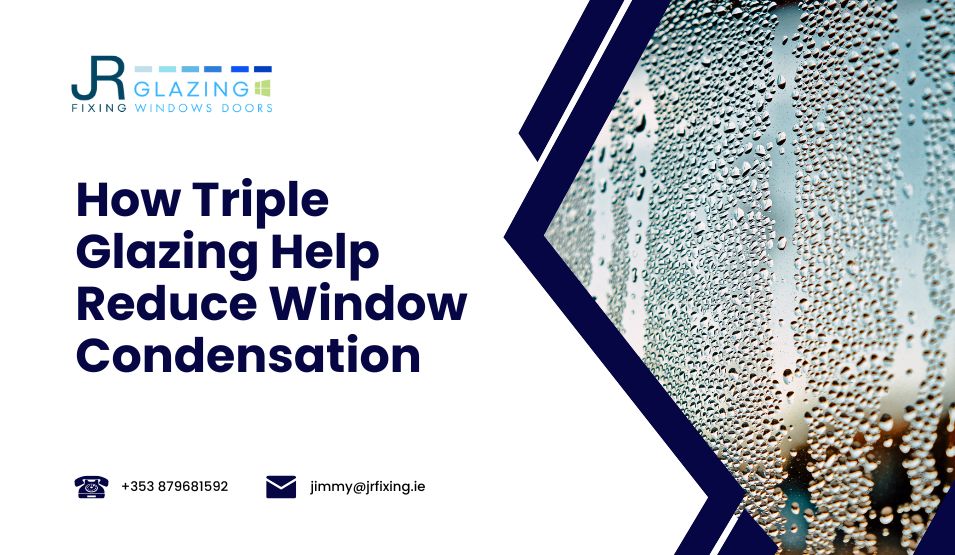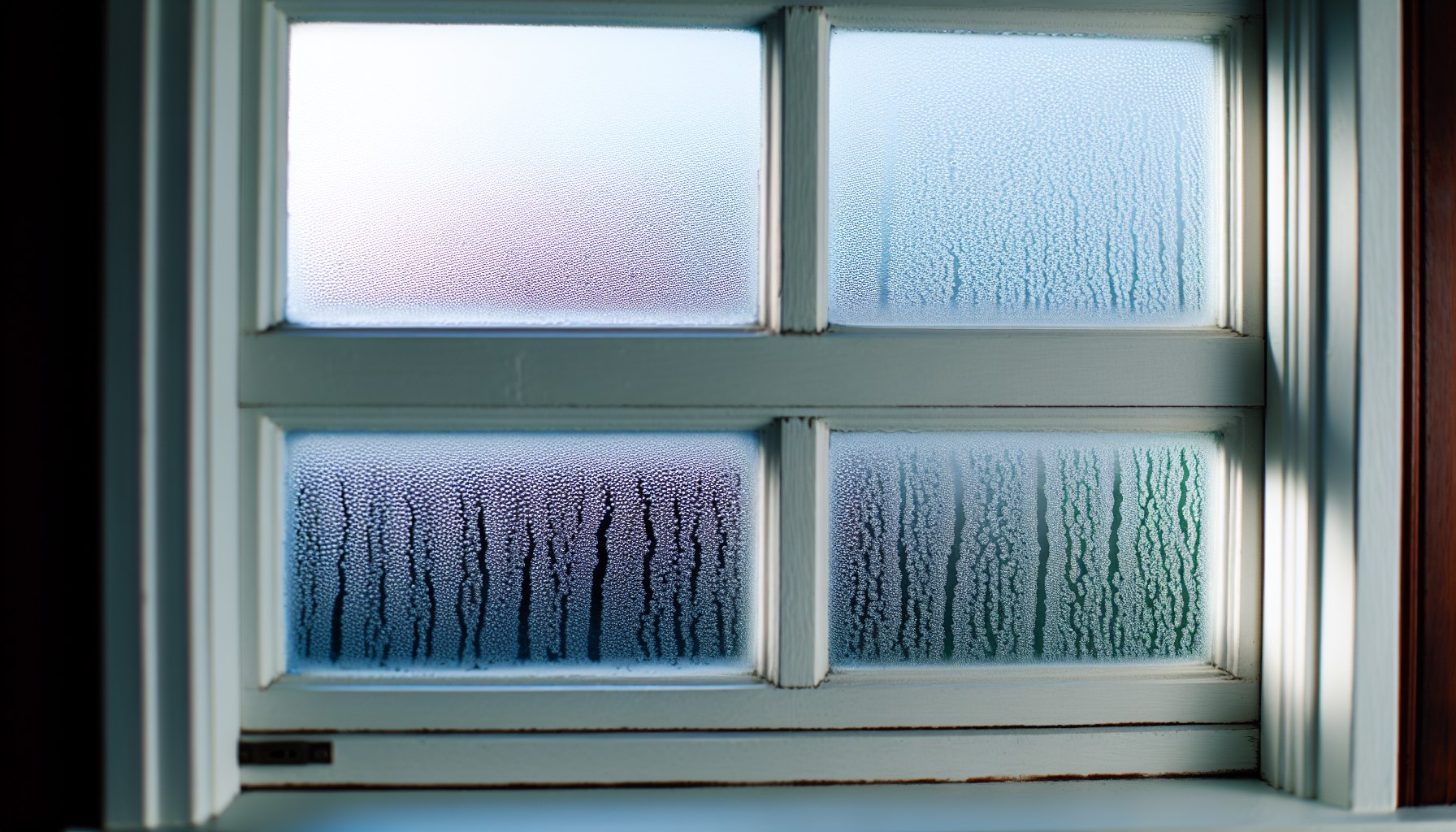Ever awakened on a chilly morning to find your windows veiled in a misty layer of condensation on outside windows? Or observed water trickling down your window panes, pooling on the sills, and leaving damp patches on your walls? This is a common scenario in many homes in Laois, especially during the colder months. But what causes this condensation? How does it impact your windows and your health? And more importantly, can triple glazing help prevent it?
Let’s embark on a journey to explore these questions and unearth effective solutions to keep your windows clear and condensation-free.
Key Takeaways
- Understand the primary cause of exterior condensation is insufficient ventilation.
- Address excess moisture indoors with proactive measures such as improved ventilation and double/triple glazed windows.
- JR Fixing Ltd provides triple glazing services to reduce condensation and improve energy efficiency in homes throughout Laois, Ireland.
What causes condensation on windows?
Condensation is a phenomenon that occurs when water vapour in the air settles on a cold surface that is cooler in temperature. It’s akin to the beads of water that form on a cold glass of lemonade on a hot summer day. In homes, condensation typically appears on windows, where moist, warm air from inside the house meets the cold glass surface.
The primary factor contributing to interior window condensation is insufficient ventilation. Think of your home as a giant container of air. When this air becomes laden with moisture from everyday activities like cooking, bathing, or even breathing, and there’s not enough fresh air circulation to balance it out, it leads to excess moisture in the air.
What are some ways to stop condensation from appearing on windows? Here are some effective measures:
- Maintain a stable indoor temperature to prevent warm air from coming into contact with cold surfaces, a primary cause of condensation.
- Enhance air circulation by using fans or opening windows.
- Open blinds and curtains during the day to allow air to circulate around the windows.
- Use moisture-absorbent materials such as silica gel packs or desiccants to reduce humidity levels.
By implementing these measures, including the use of air bricks, you can reduce or eliminate condensation on your windows.
For window treatments, it is advisable to use blinds and curtains made from moisture-resistant materials like faux wood or vinyl. Insulating window treatments, such as thermal curtains or blinds, also help reduce condensation by creating a barrier that limits the temperature differentials between inside and outside.
The Impact of External Condensation on Your Windows
Condensation is more than just a cosmetic issue. Left untreated, it can wreak havoc on your window frames, sills, and seals, leading to serious consequences. Have you ever noticed condensation appearing within your double glazing? This is usually indicative of a problem with the sealed unit of the windows.
Wooden window frames are particularly susceptible to condensation damage. The mix of dampness and strong sunlight can cause the wood to dry and crack, resulting in peeling paint and varnish, and ultimately, deterioration of the window frame. Similarly, condensation can also cause failure of the seals on uPVC windows. Once the seals fail, the window’s insulating benefits are compromised due to fogging between the panes.
The failure to address condensation can have serious ramifications. Whether they are wooden or uPVC, windows are likely to experience mould growth and a build-up of limescale. Over time, condensation can result in the deterioration of both uPVC and wooden window frames.
What is the solution for exterior condensation resulting from damaged window seals? Re-sealing windows is the recommended remedy. However, if condensation is present between the panes of a window, the seals have likely failed, and replacement of the windows might be necessary.
Triple Glazing: Your Shield Against Outdoor Condensation
Having understood the reasons and effects of window condensation, we should consider one of the most efficient solutions – triple glazing. Like a stalwart knight in shining armour, triple glazing provides an additional layer of insulation, reducing heat loss and improving surface temperatures, making it an effective solution to prevent condensation on windows.
Triple glazing works like a heat barrier. It provides:
- An inner pane that is warmer than the outer pane
- Minimises the formation of condensation on the window surface
- Reduces heat transfer through the glass
- Enhances energy efficiency
- Reduces heat loss
- Minimises the risk of condensation forming on the window surface.
What makes triple glazing superior to double glazing in preventing condensation? Triple glazing presents a diminished risk of condensation in comparison to double glazing. The minimised U-values of triple glazing allow for a smaller disparity in temperature between the panels, thus preventing condensation.
The additional layer in triple glazing is beneficial in terms of heat loss reduction. It provides an extra pane of glass and an additional air gap, both of which help inhibit heat transfer. By keeping the interior surface of the window warmer, triple glazing can be a powerful ally in your battle against window condensation.
The Battle Against Black Mould: Understanding the Connection with Condensation
While window condensation is a nuisance, the real menace is the black mould that it can spawn if left untreated. Just like a shadowy villain lurking in the corner, black mould thrives in the damp and humid conditions created by untreated condensation.
Black mould is more than just an unsightly blot on your home’s aesthetics. It can cause damage to your windows and pose significant health risks. If left unaddressed, condensation on windows can develop into mould and subsequently cause damage to the windows.
Black mould can also invade your bathroom if condensation is not properly addressed. Failure to adequately ventilate and dry the area promptly may result in the accumulation of excess moisture, which in turn could lead to the development of black mould.
What steps should you take if you notice black mould in your home? The first step is to thoroughly clean and remove it. This can be done by:
- Washing away mould with a mould and mildew spray or a solution of one part bleach to four parts water
- Drying all surfaces after washing
- Taking preventative measures to eradicate condensation
Identifying the Biggest Causes of Excess Moisture Indoors
Let’s now turn our attention indoors to pinpoint the primary sources contributing to surplus moisture and condensation inside our homes. Everyday activities such as cooking, bathing, and drying garments inside can result in heightened humidity levels, thus causing condensation on windows.
Some common sources of indoor humidity include:
- Showering and bathing
- Cooking
- Drying clothes indoors
- Having plant pots and flowers in the home
- Pets and houseplants
These activities can contribute to elevated humidity levels, excessive moisture, and the subsequent condensation on windows, all of which are signs of humid air.
How can we stop these daily activities from transforming our homes into a hotspot for surplus moisture and condensation? One simple measure is to utilise pan lids when cooking. This prevents the release of excess steam into the air. Another effective strategy is to hang laundry outside to dry, instead of drying clothes indoors, which can significantly increase moisture levels in the home.
It’s also worth noting that certain appliances, such as washing machines, can release a significant amount of moisture into the atmosphere. A washing machine can release up to two litres of moisture into the atmosphere per load of washing, resulting in higher humidity levels and potential condensation on windows. This moisture-laden air can contribute to the overall dampness in your home.
Proactive Measures to Prevent Interior and Exterior Condensation
After pinpointing the reasons and effects of window condensation, we should adopt proactive strategies to prevent it. Some measures to reduce the risk of condensation include:
- Improving ventilation
- Maintaining consistent indoor temperatures
- Using dehumidifiers
- Installing triple glazed windows
By implementing these strategies, you can effectively prevent window condensation.
Improving ventilation is one of the most effective ways to prevent condensation. This can be achieved by:
- Opening windows for approximately 20 minutes daily
- Increasing ventilation
- Keeping the house warm to avoid cold surfaces that could attract condensation
- Installing an energy-efficient extractor fan, especially in kitchens and bathrooms, to help regulate humidity levels and prevent condensation.
Keeping a stable indoor temperature is another effective measure to prevent condensation. This can be achieved by:
- Closing curtains
- Shutting doors
- Using thermal or insulated curtains
- Sealing gaps around windows and doors
Additionally, using a dehumidifier and investing in a moisture metre can help manage indoor humidity levels, prevent condensation, and monitor the dew point.
For a more permanent solution, consider installing triple glazed windows. Upgrading from single-glazed windows to triple glazing and installing extractor fans in the kitchen and bathroom can effectively reduce condensation. Triple glazing helps reduce the amount of heat that is lost from a property, thus maintaining the interior surfaces at a higher temperature, resulting in increased energy efficiency and reduced condensation.
Harnessing the Power of Triple Glazed Windows with JR Fixing Ltd
If you are thinking about triple glazing as a remedy for your window condensation problems, JR Fixing Ltd is ready to assist. Offering triple glazing services in Laois and the surrounding counties such as Kildare, Carlow, Offaly, and Kilkenny, we are committed to providing you with an efficient solution to reduce condensation and enhance energy efficiency in your home.
Our triple glazed windows offer numerous benefits, including:
- Enhanced energy efficiency
- Reduced heat loss
- Improved security
- Thermal insulation
- Noise reduction
By installing triple glazed windows, you not only prevent condensation but also improve the overall comfort and energy efficiency of your home.
To reduce condensation, we install triple glazed windows while ensuring adequate ventilation. As we’ve learned, ventilation is the most effective way to reduce condensation on windows, regardless of the glazing type.
Frequently Asked Questions
Is condensation on the outside of windows bad?
Condensation on the outside of windows is a sign that your windows are effectively preventing heat loss from your home, so it should not be seen as a bad thing.
How do you stop exterior condensation on windows?
Increase exposure to sunlight and gentle breezes/winds to warm the outer window glass and evaporate the moisture to stop exterior condensation.
What causes condensation on windows?
Condensation forms on windows when warm, moist air from inside comes into contact with the cold glass surface.
How can triple glazing help prevent window condensation?
Triple glazing reduces heat transfer, enhances energy efficiency, and reduces heat loss, making it an effective solution for preventing window condensation.
How does JR Fixing Ltd help reduce window condensation?
JR Fixing Ltd can help reduce window condensation through our triple glazing services, improving energy efficiency for your home.




